Introduction
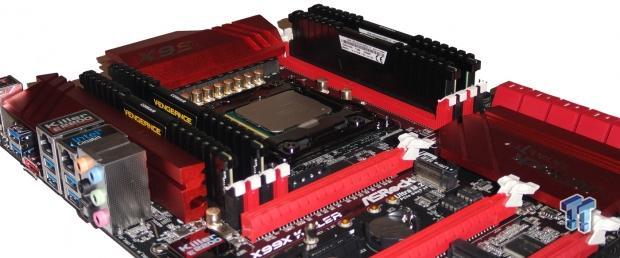
Intel Haswell-E. Talk about a codename that we've felt like we've been hearing about forever. Ready for enthusiasts, the new processors when paired with the new Wellsburg chipset, or X99 as we know it as, will come together to create your new high-end system that is set to replace the aging X79 platform. It feels like most the time when we use the word "aging" we're talking about something that is a year old. Not the X79 platform, though, this is a platform that has been around for what feels like an eternity.
Gracing us with its presence towards the end of 2011, the X79 chipset has been around for a long time with it tipping almost three years. When it comes to the world of computers, this is a long time. To give you an idea, when it came to other areas, we were looking at the HD 6970 from AMD when it comes to video cards, quad-channel memory kits at speed only as high as 2400MHz DDR and 512GB SSDs that cost nearly $900. Now we've got the dual GPU R9 295X2, kits of memory that support speeds in excess of 3000MHz DDR out of the box, and 1TB SSD drives that are not only a whole lot faster, but also priced at under $700, and some less than that.
If you found yourself as an early adopter to the platform, it's more than possible that you're still sitting on it. While chipsets like the Z87 and Z97 have represented much better value over recent time, the simple fact remains that people who wanted a large amount of cores or video card setups that expanded past two were best buying a system based on the X79 platform due to its strong enthusiast nature. For that reason, my own video card testbed has been based on the X79 chipset since almost launch. Apart from a slight CPU upgrade over that time, it hasn't changed much at all with the ASUS ROG based board continuing to perform exceptionally strong even now.
This is one of the largest PC launches in a long time, as the new platform brings with it not only a whole new chipset, but a shift to brand new DDR4 memory as well. With a new chipset and the shift to DDR4, it's a little hard to figure out where we should be starting first. It's fairly safe to assume that the new Intel Core i7 5960X EE processor is going to be the item that most people will drool over thanks to its $999 price tag and eight cores. For that reason, it's going to be the first piece of the puzzle we're going to look at, and why you're here right now.
While today our main focus will be on the performance of the CPU, we will also be covering the new X99 chipset in the following pages, along with a bit about DDR4. Once we've looked at the processor, we'll be moving into a mountain of X99 based motherboards and DDR4 memory kits that have already gathered in our lab to see just what you should be pairing with this beast of a processor.
At times it can be a little tough to get truly excited about what's going on in the hardware industry. However, with a new high-end chipset, a CPU that sports a bunch of cores and the latest in memory technology, I can say that I'm genially pumped to see how the new platform goes. So, let's leave it here, and see what the new Haswell-E processor line up looks like, before we get into the all-important performance numbers later on in the review.
PRICING: You can find the Intel Core i7-5960X 3.0 GHz Extreme Haswell-E Processor for sale below. The prices listed are valid at the time of writing but can change at any time. Click the link to see the very latest pricing for the best deal.
United States: The Intel Core i7-5960X 3.0 GHz Extreme Haswell-E Processor retails for $1049.99 at Amazon.
Haswell-E - The New Processors
Like any new platform launch, the main parts that Intel want to concentrate on are of course the high-end parts. We absolutely love that. At the same time, though, we won't deny the fact that we'd love to also see Intel sample the lower-end parts of the new platform, especially when using the word "lower" seems like an insult to the other models. The new Intel Core i7 5960X Extreme Edition (EE) sits at the top of three new processors that are launching alongside the new X99 platform.
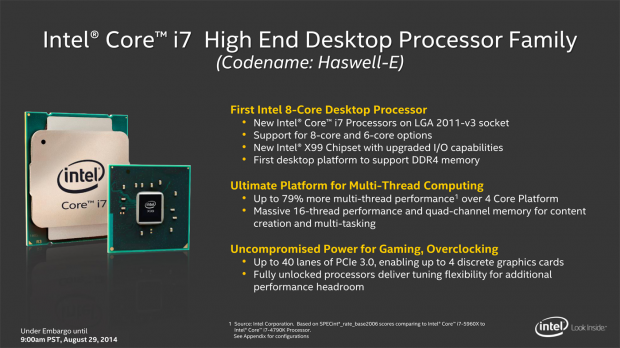
The new i7 5960X EE is the first Intel eight-core processor that is aimed for desktop users. While eight core and higher processors are indeed offered by Intel, the new i7 5960X EE is the first to be aimed at the desktop user. Instead these massively cored CPUs have been reserved for the Xeon line which is aimed at the workstation, enterprise, and server market. This new LGA2011-v3 socket processors are compatible with not only the new X99 chipset that has launched beside it, but also with DDR4.
While the i7 5960X EE carries eight physical cores, thanks to Hyper-Threading being offered, we see a total of 16 threads on the new Extreme Edition processor. Out of the box, the processor supports DDR4-2133, but with the help of overclocking and memory dividers, we know from past experience that going higher than that isn't going to be much of an issue.

Out of the box, the i7 5960X EE has a base clock of 3GHz that is then pushed up to 3.5GHz via Intel's Turbo Boost 2.0 technology. Being an Extreme Edition part means that we've got a fully unlocked multiplier to assist in overclocking the processor to even higher clocks - this is one area we're extremely interested in. With 40 PCIe 3.0 lanes integrated into the core, we've clearly got a CPU that is designed for massive video card setups. With a massive 20MB of cache, paired together with all the other features, you'd be hard press to deny that this isn't a processor for someone wanting to build the ultimate gamer's machine.
An ultimate gaming machine comes at a price, though, and with its high, but expected $999 price tag, it's easy to quickly close your eyes and pretend it doesn't even exist as it sits out of reach. So, what if you want to jump on the latest and greatest motherboard and memory technology, but don't want to spend a cool $999 on your processor? There are other options.
As we mentioned, the new i7 5960X EE launches alongside two other processors, which don't quite carry the same sticker shock price that is associated with Intel's top model. Looking below, you can see the new Intel Core i7 5930K and 5820K. When it comes to similarities, all three processors support a fully unlocked multiplier, Hyper Threading, quad-channel DDR4-2133, Turbo Boost 2.0, a 140W TDP and the same LGA 2011-v3 socket.

That's where the similarities stop, though, as the first major difference between these two processors and the top EE one is the fact they're utilizing a six core / 12 thread setup instead of the massive eight core / 16 thread setup. The next big difference comes in the clock speeds - both of these more affordable core processors actually come in clocked higher with the i7 5930K coming with a 3.5GHz base clock, which is pushed up to 3.7GHz via Turbo Boost 2.0. And the i7 5820K carries a 3.3GHz base clock, which is then pushed up to 3.6GHz via Turbo Boost 2.0.
Moving away from the clocks, another major difference between the three processors is that while the EE carries an epic 20MB of cache, the i7 5930K and i7 5820K parts are reduced down to 15MB of cache. Combined with the reduced cores, the two K based processors should still come in slower, even with the higher out of the box clock speeds that are offered by Intel.
One of the more interesting changes, though, comes in terms of PCIe 3.0 lanes. While the i7 5930K brings with it the same 40 lanes that are offered on the X variant, the i7 5820K brings with it a reduced 28 lanes. This is the one feature that will separate the people wanting larger three or four video card setups, and those who are just one or two.
Out of everything, though, the biggest difference comes from the price which can be seen on the right hand side. Priced at nearly half, the $583 price tag associated with the i7 5930K looks a lot more attractive than the $999 one associated with the X version. Moving down to the i7 5820K brings a further price drop with its $389 tag. Apart from the 100MHz difference, depending on the video card setup you're looking at, the i7 5820K could carry with it's the best overall value, depending on your specific needs. Without testing them, though, it's a little difficult to know just exactly how all three processors perform. Hopefully we'll get a chance to look at the lower models from Intel at a later date.
Wellsburg (X99) - The New Chipset
Outside of the new crop of processors, the new Haswell-E based processors require a new series of motherboards, featuring chipsets known as codename Wellsburg, or more commonly known as X99. Looking below, you can see what exactly the new processors and chipset are capable of handling.
When it comes to the CPUs, we know that up to 40 PCIe lanes can be offered. Below, though, we can see the kind of configuration they can be in - a dual x16 setup with a single x8 or an option that supports five x8 PCIe slots. Along with that, though, you can see the internal memory controller is capable of handling a quad-channel DDR4 setup with speeds up to 2133MHz officially (without added overclocking).

Moving away from what the CPU features are, we can see just what is brought to the table via the new X99 chipset. Offering support for a massive 14 USB ports, you can see up to six of those can be USB 3.0, while the other eight can be USB 2.0. Along with that, we've got integrated gigabit networking.
Looking at the other side, you can see that Intel HD Audio is brought to the table, along with a further eight PCIe slots. Looking closer, though, you can see these are just 2.0 slots and not newer 3.0 like the ones supported on the processor. Out of the box, the new X99 chipset will also offer support for 10 SATA ports with all 10 of them being SATA III with support for optional Intel Rapid Storage technology. Looking across the bottom, you can see that we've got support for Intel Management Engine Firmware 9.1 & BIOS support, while Intel Extreme Tuning Utility is also supported.
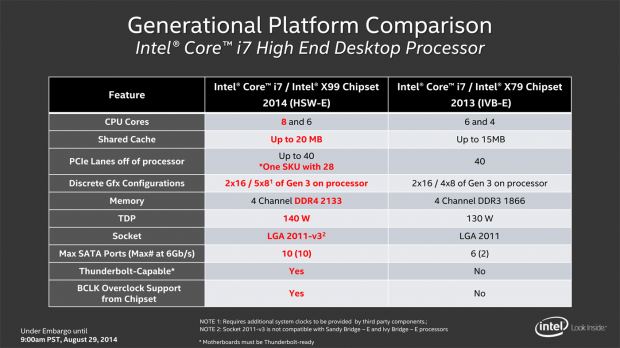
Looking above, you can see just how the new Haswell-E platform compares to the previous Ivy Bridge-E platform. Starting from the processor, you can see we're now able to get eight-core CPUs with up to 20MB of cache. PCIe lanes offered are the same, although, you can see one SKU carries a reduced 28 lanes. When it comes to discrete video card configurations, you can see both are similar with the newer Haswell-E processors supporting a fifth PCIe x8 lane.
One of the major difference, though, is the fact that instead of quad-channel DDR3 1866 on the previous X79, the new platform offers support for quad-channel DDR4 with speeds up to 2133MHz. Finally, we finish up the main CPU differences with the new Haswell-E processors having a slightly higher TDP with 140 watt being seen instead of 130 watt. Thunderbolt is capable on certain motherboards that opt for it and BCLK overclocking support is offered from the chipset.
Benchmarks - Test System Setup and Overclocking
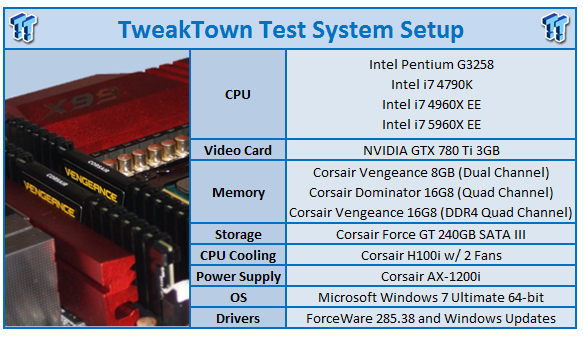
We would like to thank the following companies for supplying and supporting us with our test system hardware and equipment: Intel, ASUS, MSI, Western Digital, MemoRight and Corsair.
It's been ages since we have changed our CPU benchmark line up. If we're completely honest, because CPU launches are quite few and far between, the benchmark line up for CPUs don't get the same attention as what our motherboard and video card ones do, which are constantly evolving. While we've added a slight addition to the CPU benchmark line up, the biggest change comes from the latest versions of everything now being used.
PCMark 7 has moved to PCMark 8 and all three benchmarks that focus on the system are included. AIDA64 is up to date, along with PassMark PerformanceTest, which now also includes more results than we previously had. CINEBENCH has also been moved to R15 with both the OpenGL and CPU results being included. Lightroom has been upgraded and the export has become more intensive, hence placing more load on our system. While MediaEspresso hasn't changed, Handbrake has been added to include another encoding option. Finally we finish off with our gaming benchmarks that include 3DMark 8, along with Sleeping Dogs.
Before we get into the performance of the new i7 5960X EE, though, we need to cover the overclocking side of things to see just how much performance we can get out of this new processor. Any time it comes to overclocking a new processor, it can be a little difficult to know where to go. Everything then becomes even more confusing when you throw a new chipset into the mix, and a new type of memory as well.
Still, with that said, we headed into the BIOS to see just what we were able to do with the Intel Core i7 5960X EE which is sitting in the brand new ASRock X99X Killer motherboard. We haven't got into many specifics on the motherboard as we will be covering it in much more detail in its own review following this one.
When it came to overclocking, we wanted to keep it simple for now. With no experience with both the chipset and the CPU, we figured it was best to just play it safe. Earlier in the day, I saw someone post a screen shot of their 5960X EE running at a cool 4GHz. I figured that was a nice number to be at and thought if we could get that far, we'd be onto a good thing. Fortunately the ASRock board has its own nice little section for pre-configured overclocks. Going into the menu, you're greeted with overclocks that range from 4GHz to 4.5GHz with the latter being highlighted in red.
Heading into the BIOS, we started at 4GHz and found everything working fine. We moved to 4.2GHz and had no issues either. We jumped again to 4.4GHz and with much surprise, there were also no issues. We tried the last one, 4.5GHz, which is highlighted red, and ran into a BSOD, as soon as we started benchmarking.

Looking above, you can see we ended up with a final clock speed of 4397MHz or 4.4GHz, as shown in our graphs today. This is an awesome overclock that was done with complete ease. It's a little tough to tell if this is a good CPU or not as we have nothing to compare it against. As we get more comfortable with the chipset and the CPU, though, I feel we're going to really be able to achieve an even higher overclock. This is a fantastic start, though, and a real testament to the ASRock board when it comes to making overclocking so easy.
Benchmarks - PCMark 8, HyperPi and AIDA64
PCMark 8
Version and / or Patch Used: Latest Steam Update
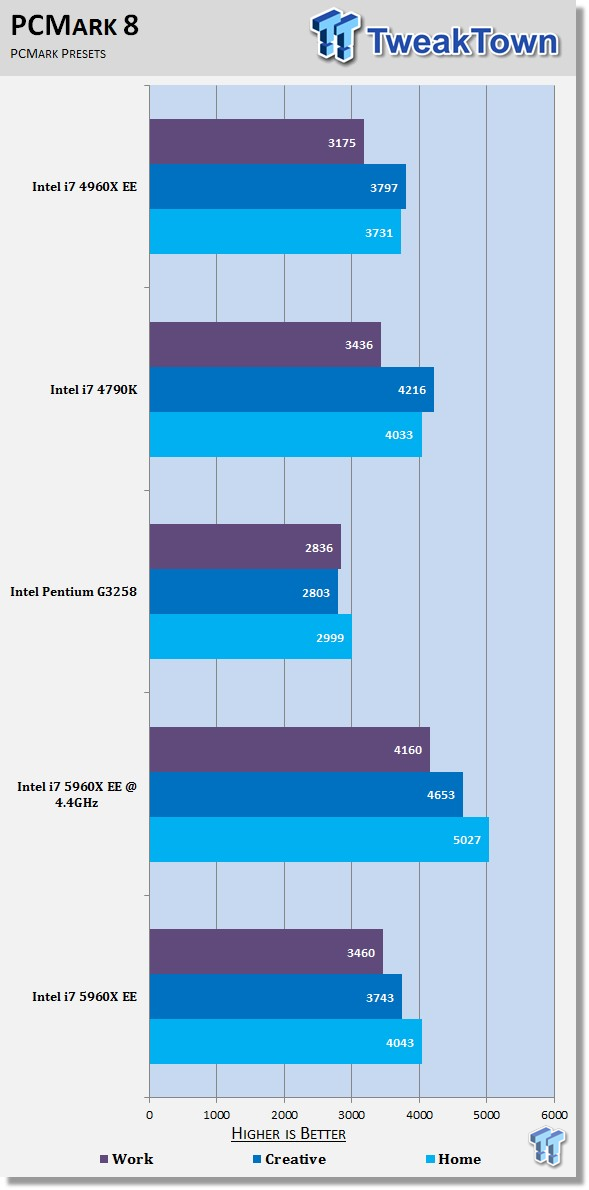
When it comes to stock PCMark 8 performance, you can see the i7 5960X EE sits just ahead of the i7 4960X EE. Sitting just ahead, though, means that we're falling behind the i7 4790K and its higher clock speeds. Saying that, though, you can see when it comes to the Home preset, the i7 5960X EE manages to sneak out just slightly ahead of it i7 4770K.
Overclocking yields some massive gains across the board that put it easily ahead of everything else. You could argue overclocking the i7 47960K will also yield big performance gains. However, our testing has shown due to the limited amount of overclocking headroom on the platform, there's not all that much more performance to be had out of it under PCMark 8. You can get a closer look at this from any of our recent motherboard reviews.
HyperPi 0.99
Version and / or Patch Used: 0.99

While out of the box the i7 5960X EE performance is stronger than the i7 4960X EE, you can see it does lag behind the i7 4790K in this particular benchmark. When it comes to overclocking, though, it really is more down to the raw clock speed under HyperPi, as we see our i7 5960X EE close the gap significantly and score pretty much even with the i7 47960K.
AIDA64
Version and / or Patch Used: 1.00.1035BETA


Looking at cache performance out of the box, you can see it just blows the other setups out of the water. The L2 and L3 numbers are great against the other processors, but you can see the L1 numbers are just huge, jumping well and truly in front of everything else.
Increasing the core clock a solid 900MHz just helps push those performance numbers even higher. You can see at this speed the new i7 5960X EE on the X99 platform leaves everything else for dead.
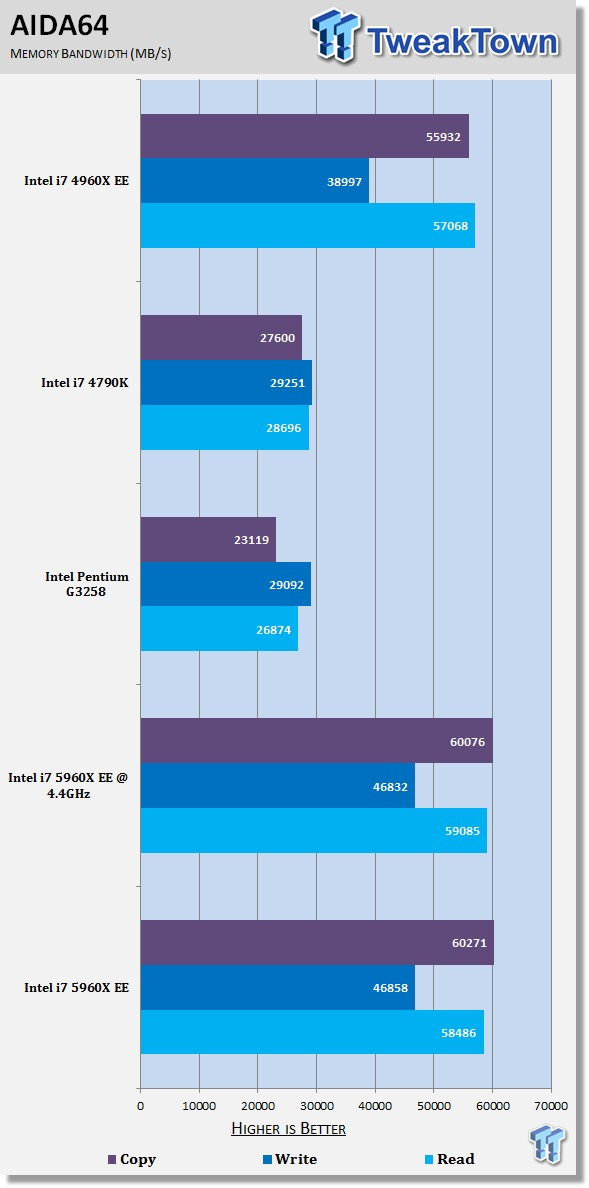
Looking at quad-channel DDR4 performance against DDR3 performance, you can see while the read number jumps only slightly, the write and copy numbers show more of a gain against it. When it comes to overclocking, you can see that just like the Z97 and Z87 platform, the extra MHz clock from the CPU does little to nothing to improved memory performance.
Benchmarks - PassMark PerformanceTest, CINEBENCH and Adobe Lightroom
PassMark PerformanceTest
Version and / or Patch Used: 8

PassMark performance is quite interesting. Looking above, you can see the new Intel Core i7 5960X EE sits with the i7 4960X EE and falls behind the i7 4790K. While RAM and 3D performance sit quite close to each other, you can see the Extreme Edition CPUs clearly benefit when it comes to the CPU testing side of things.
The i7 4960X EE shows a clear lead over the i7 4790K, while the i7 5960X EE jumps even further head, and really by quite a decent margin. When it comes to overclocking, you can see that the i7 5960X EE at 4.4GHz helps close the gap between the overall score - but it still remains slightly below the i7 4790K.
CINEBENCH R15
Version and / or Patch Used: R15
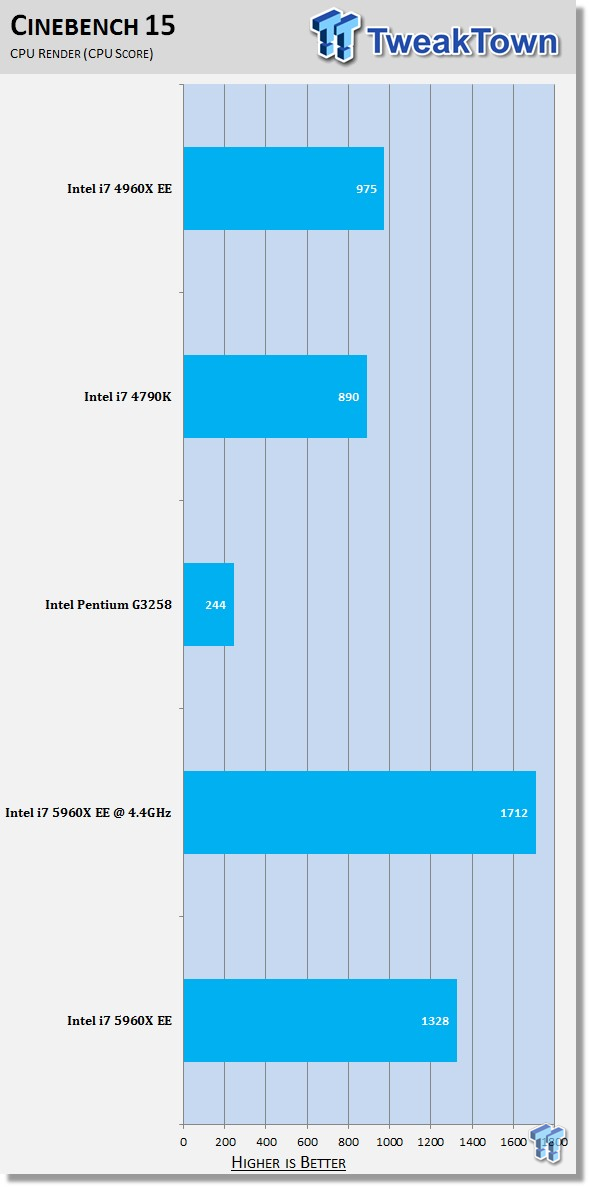

CINEBENCH performance is again quite interesting. In the OpenGL portion of the test, you can see that the i7 4790K and i7 5960X EE perform quite closely to each other, with the latter actually falling behind. As soon as we shift the focus onto the CPU side again, though, you can see the new i7 5960X EE jumps ahead of both setups with the gain being around 35% when compared to the i7 5960X EE, and even further when compared to the i7 4790K.
As you can see when we crank the clock speed of the i7 5960X EE to 4.4GHz, performance goes through the roof again. You can see we're at almost double the performance of the stock i7 4790K, and really not that far off double when it comes to the i7 4960X EE.
Adobe Lightroom
Version and / or Patch Used: v5.6

Looking at Lightroom performance, you can see that the i7 4790K manages to beat out the older i7 4960X EE by a small margin. Jump forward to today, though, and you can see the new Extreme Edition i7 5960X EE manages to come out ahead.
When we throw overclocking into the mix, though, we see a massive jump in performance of over 20%, and thanks to that, you can see it manages to jump ahead of everything else once again. Overclocking is clearly a big deal for the 5960X EE.
Benchmarks - MediaEspresso and Handbrake
MediaEspresso
Version and / or Patch Used: v6.5

Taking a look at MediaEspresso, we see similar results to what we saw under Lightroom. At stock, you can see the i7 4790K manages to beat out the old EE based i7 4960X EE. Moving to the newer i7 5960X EE, you can see it manages to pull out a win against both processors.
MediaEspresso also sees some awesome gains when overclocking is thrown into the mix. Looking above, you can see it's in the sub 11 minute mark for the encode process.
Handbrake
Version and / or Patch Used: v6.5

Handbrake makes some serious use of the power that is on offer from Intel's Core i7 5960X EE CPU. Looking above, you can see it's significantly faster than our other processors. Compared to the next closest processor, the i7 4960X EE, it's almost 40% faster.
Handbrake already makes awesome use of all the cores and the extra cache that is on offer from the i7 5960X EE. When you throw a 900MHz overclock into the mix, the average FPS during the encode jumps around 30%. Compared to the stock i7 4790K, you can see that performance is almost double here in favor of Intel's newest processor.
Benchmarks - Gaming & Power and Temperature Tests
3DMark 8
Version and / or Patch Used: 1.0

Sleeping Dogs
Version and / or Patch Used: Latest Steam Update
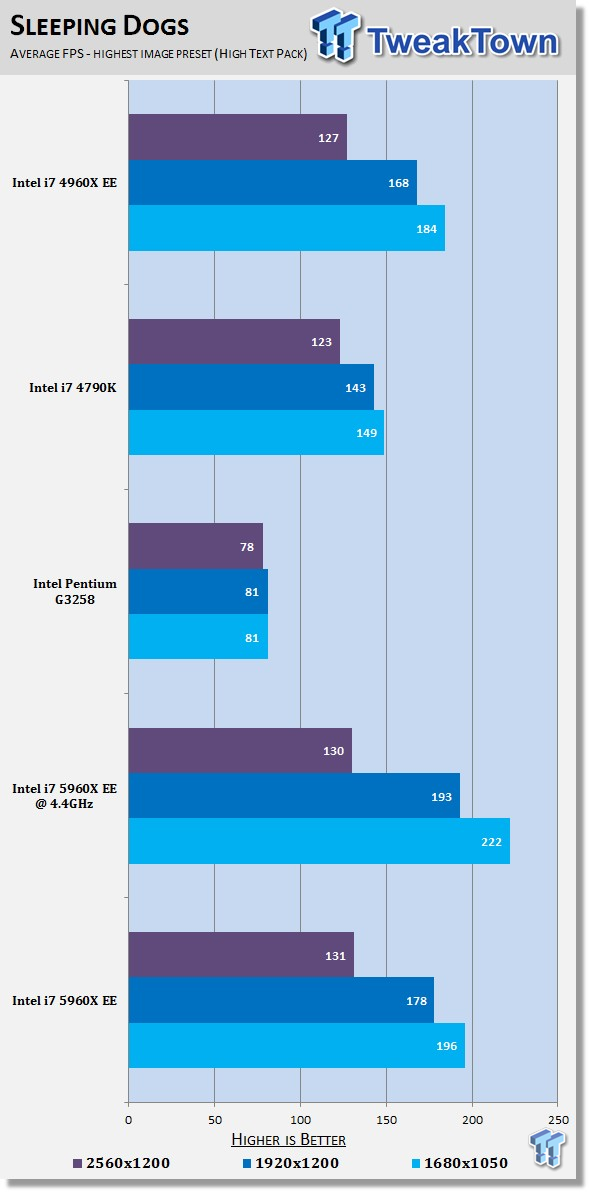
When it came to gaming performance, I really thought that our high-end CPUs would all pretty much be even. Looking above, though, you can see that the new high-end i7 5960X EE manages to pull slightly ahead in all tests, except the high resolution 3DMark 8 test, where we see no real change.
Under 3DMark you can see overclocking adds a little bit of positive movement, but overall not too much. Sleeping Dogs on the other hands sees some great gains at the lower resolution, where less focus is put on the GPU, and more on the CPU itself.
Power Consumption Tests

Power draw on the system is strong, and slightly better than we thought it would be at first. At both idle and load, the new Intel CPU sits towards the middle of the pack, when it comes to testing the default clock speed.
With overclocking, the idle doesn't change much, but the load jumps up, as you'd expect. At 433 watts, though, the number is quite impressive, considering the amount of power on offer from this awesome setup.
Temperature Tests
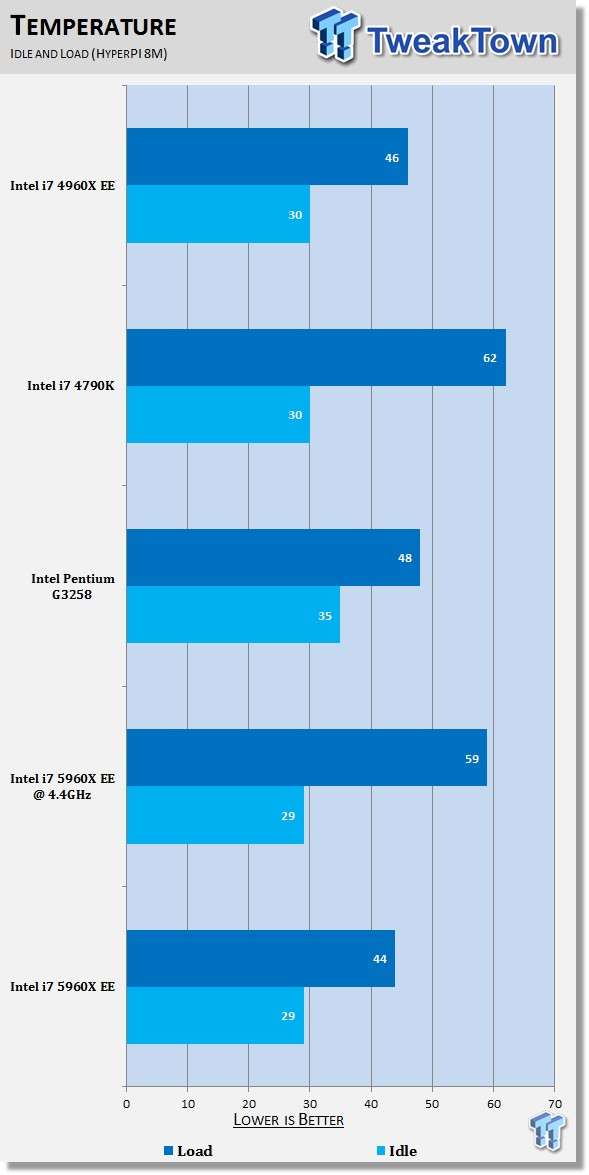
Taking a look at the temperature out of the box, the new i7 5960X EE pretty much lines up with the previous generation EE CPU in both the idle and load departments. While the i7 4790K also sits in line with these two processors, when it comes to idle temperature, you can see the load number sits much higher. Temperature numbers from the setup are really quite amazing.
Overclocked, you can see above, we're only seeing a load temp of 59c, which is lower than the i7 4790K when it's at stock. We also know when overclocking, hitting 90c isn't rare on that processor.
Final Thoughts
You would be extremely hard pressed to say that you don't want this CPU. You could say that it's too expensive for you, you could say that it's just too expensive for what it is. You can say a lot of things, but saying you don't want this setup doesn't really seem like one of them. This is an awesome processor from Intel - really, really awesome.
Performance limitations really come from the software and games that you're using. We need companies to write software and games that can make full use of the cores that are on offer here. While the extra FPS we see under Sleeping Dogs isn't really needed, the fact that we get it is a good thing. It means that we're able to make use of the processor.
Of course, when it comes to gaming and gaming at higher resolutions, the load from the CPU is ultimately removed and instead all placed on the video card setup. On the other hand, if you go into a setup that is high-end enough, you need all the CPU power you can get to make sure that you don't hit any kind of CPU wall, something that continues to be present on even single card setups.
When you look at something like encoding under Handbrake, you can see a program that is really able to make use of everything that is being offered from the new CPU. Looking at the cores, you see every single core bounding around that 97% - 100% when it comes to usage. It's because of that we can see Handbrake shows massive gains when compared to the other setups at stock, but also massive gains when compared against itself when overclocked. It's making use of an extra 900MHz on every single core, which in turn is offering amazing performance.
The elephant in the room when it comes to these Extreme Edition CPUs is always the price. It doesn't matter which way you look at it, $999 for a single item with in your system is just a ton of money, especially when you consider the other parts you also need to buy to really make use of it. When it comes to buying a desktop processor, this is simply the best CPU on the market, without any doubt at all. The performance is amazing and the eight cores that blow out to 16 threads thanks to Hyper-Threading means you've just got a massive truck load of computing power at your mercy.
Would I recommend this CPU to everyone? Of course not. If you told me you're looking to build a single GPU setup or even a dual GPU one, I'd say every day of the week you're better off looking at one of the other (cheaper) options. With 40 PCIe 3.0 lanes on offer, the i7 5930K and its $583 price point is the best option for people wanting to build a serious dual card setup. On the other hand, if you're looking for just a single card solution, even if it is a Dual GPU one like the R9 295X2, then we'd probably lean more towards the i7 5820K. With 28 PCIe 3.0 lanes instead of 40, it's a great option for people who just need a single PCIe x16 slot.
Of course this comes from the perspective of someone who is gaming. That's the main focus for us here as we know that's what a large amount of our reader are. When it comes to needing a CPU for real desktop tasks, though, and using applications that can make use of the full eight cores and 16 threads, it becomes a bit of a different picture. The big problem is without testing the other processors personally, it's hard to say which exactly the best to buy is. We can't deny the fact, though, that if you've got the money and you've got the applications that can make use of all those cores and threads, the 5960X EE is clearly going to be the best option.
If you've got the money and you've been dreaming about building that dream rig, the simple fact is that while you might not need the i7 5960X EE, we're going to see a ton of people purchase it because they simply want the best of the best. They're going to team it up with a beautiful 1TB SSD drive or two, a massive 32GB or 64GB of DDR4 - speaking of which, brings us to another topic.
Quad-channel DDR4 brings more performance to the table. We don't doubt that for a second. The question is, where do we see that extra performance? It's really a little hard to pin point right now. DDR4, the X99 chipset and the new Haswell line of processors are all integrated and designed around each other, and designed well. DDR3 has really run its course and it's been quiet in the market for at least a year now. While we're not exactly sure just where DDR4 really helps yet, we can't deny that we love that it's here, and running together nicely with Haswell-E and the X99 chipset.
The Extreme Edition crop of processors have a certain kind of person in mind: those that demand the absolute best, and are willing to pay for it. If you're that kind of person, welcome to your new processor, it's a very easy choice to make. If you're not, though, the good news is that Intel are thinking of you. While we haven't tested them, based on the information we have, past history and just our general understanding of how this area works, the i7 5930K and i7 5820K are very capable alternatives that aren't going to bust the bank account wide open.
While you might be tempted to just skip the i7 4790K and move to the i7 5820K which sits just $50 more expensive, you can't forget that both the X99 platform is going to add a premium, along with the need to buy new memory (DDR4). While $50 for the new processor might not seem much, the other parts will add up and make building an X99 DDR4 machine quite a bit more expensive than a Z97 DDR3 system.
Intel's Core i7 5960X EE is just the first part to a three piece puzzle. Keep an eye out for a look at our first DDR4 review, along with a much closer look at the impressive ASRock X99X Killer motherboard, which we used in this review to test the CPU. The platform on a whole is a ton of fun, and I'm really looking forward to testing more and more parts based around it. For now, though, we'll leave you with this drool worthy piece of hardware.
PRICING: You can find the Intel Core i7-5960X 3.0 GHz Extreme Haswell-E Processor for sale below. The prices listed are valid at the time of writing but can change at any time. Click the link to see the very latest pricing for the best deal.
United States: The Intel Core i7-5960X 3.0 GHz Extreme Haswell-E Processor retails for $1049.99 at Amazon.


 United
States: Find other tech and computer products like this
over at
United
States: Find other tech and computer products like this
over at  United
Kingdom: Find other tech and computer products like this
over at
United
Kingdom: Find other tech and computer products like this
over at  Australia:
Find other tech and computer products like this over at
Australia:
Find other tech and computer products like this over at  Canada:
Find other tech and computer products like this over at
Canada:
Find other tech and computer products like this over at  Deutschland:
Finde andere Technik- und Computerprodukte wie dieses auf
Deutschland:
Finde andere Technik- und Computerprodukte wie dieses auf